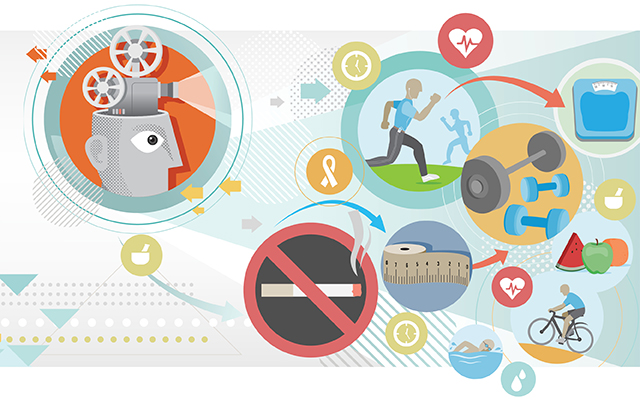|
Listen to this article:
|
We often use the word “addicted” casually to convey fandom or devotion. “I’m addicted to TikTok.” “I have a cycling addiction.” Does this minimize addiction — or does it demonstrate that addiction is more pervasive than we might assume?
Though it has long been associated with drugs and alcohol, a growing body of research suggests addiction can take other forms — many of which don’t contain a single chemical. From shopping to social media to sex, a wide range of behaviors hold potentially addictive properties.
And not only do behavioral addictions operate along similar psychological and neurological frameworks as their chemical counterparts, they can have just as much potential for destruction.
What Causes Addiction?
A confluence of factors inform addiction, some of which take root before we’re even born.
The biopsychosocial model believes that genes and neurological structures (biology), patterns of thought and behavior (psychology), as well as community, family, and peer relationships (social) all influence our vulnerability for addiction.
These factors are distinct yet highly interdependent. Consider the case of “George.”
George’s parents have a history of substance abuse and are often passed out, high, or out of the home throughout his childhood. He not only inherits a genetic predisposition for addiction, George receives little emotional support from his parents. He learns to numb his emotions through compulsive thumb-sucking and, later, by smoking marijuana. By the time George reaches high school he is smoking every day.
Behavioral addictions not only operate along psychological and neurological pathways similar to those of chemical addictions; they also have just as much potential for destruction.
Though he only became physically addicted to marijuana once he started using it regularly, it’s safe to say the seeds of George’s substance abuse were sown long before then. Once George begins using marijuana, the physiological mechanisms of addiction kick in.
Though addictive substances trigger a number of neurochemical reactions, none contribute to dependency more than dopamine. Known as the “feel good” hormone, dopamine occurs naturally in our brains. Drugs don’t contain dopamine; rather, they trigger its release. The more dopamine a substance releases and the faster it releases it, the more addictive that substance is.
In the brain’s reward system, pleasure and pain work like a scale that wants to balance out and remain level. Every time the balance tips too far to the pleasure side, self-regulating mechanisms reflexively bring it level again. Think “what goes up must come down” (or just imagine having a hangover after a big night out).
With prolonged drug or alcohol use, the balance gets weighted to the side of pain and the capacity to feel pleasure decreases. The resulting dopamine-deficit state means one must use greater amounts of the substance to get the same effect, a phenomenon commonly referred to as tolerance.
This leaves someone like George physically dependent on marijuana to feel good: The more he uses it the more he needs it, and the worse he feels without it. Compulsive and often destructive behaviors ensue, as the urge to use outweighs even the most serious consequences. This is why addiction so often leads to ruptured relationships, lost jobs, and major medical issues.
What Can We Get Addicted To?
Now imagine that instead of marijuana, George’s peers and family members were “addicted” to online gaming. On the surface, gaming may seem a poor comparison and, in some ways, it is: Pleasurable behaviors activate our reward centers but not close to the level of drugs. For example, studies find that sex triggers the release of dopamine in rats by 100 percent, and amphetamines triggers it by 1,000 percent.
Yet mounting evidence suggests that behavioral addictions such as online gaming activate the same neural circuitry as their chemical counterparts.
A study comparing “internet addicted” adolescents and a control group found significant differences between their blood dopamine levels, evidence that behaviors, not just substances, can disrupt our pleasure–pain balance.
Other research shows how social media replicates the “variable reward schedule” of gambling. On social media, “likes,” “follows,” and “shares” trigger a small release of dopamine, but do so on an unpredictable schedule: like a slot machine, the rewards are random. We never know when we’ll get another hit, which can lead to compulsive posting, scrolling, and checking.
Currently, gambling is the only behavioral addiction recognized in the Diagnostic and Statistical Manual of Mental Disorders (DSM). Gambling’s diagnostic criteria mirrors that of substance-use disorders: A need to gamble in increasing amounts to feel satisfied; difficulty stopping; preoccupation with past or future gambling experiences; and continued gambling despite negative consequences.
Many mental-health experts have been advocating for other behaviors to be considered under the framework of addiction, including online gaming, sex, social media, and shopping. All trigger a dopamine release, which means all can upset the pleasure–pain balance.
Is Everything Addictive?
If positive experiences release dopamine and dopamine fuels a desire for more dopamine, does that mean any activity we enjoy has the potential to be addictive?
The American Psychological Association defines addiction as a state of psychological and/or physical dependence on a substance — “and sometimes applied to behavioral disorders.” Dependence is an amorphous term, yet the DSM criteria for addiction-related disorders helps clarify this.
To be considered an addiction, use of a substance or behavior must result in negative consequences — deteriorating physical or mental health; ruptures in relationships; difficulty functioning at work, home, or school.
To be considered an addiction, use of a substance or behavior must result in negative consequences — deteriorating physical or mental health; ruptures in relationships; difficulty functioning at work, home, or school. And, above all, it includes an inability to stop using the addictive substance or doing the behavior in spite of those consequences.
So, we may enjoy a particular activity and miss or even crave it when it’s gone, but if we’re not dependent on that activity for our well-being and it doesn’t lead to negative consequences, it isn’t considered an addiction.
Consider “Suzanne” and “Mike.”
Suzanne loves to run and does so nearly every day. She feels a little off if she can’t hit the treadmill —she’s not getting her dopamine hit — but it doesn’t ruin her day.
Mike also runs every day — even when he’s not feeling well. In fact, he frequently prolongs illnesses or injuries because he refuses to take a break. Mike prioritizes running above everything else: he’ll cancel plans or call in sick to work if he must.
Suzanne’s running habit doesn’t lead to negative consequences, and she can cut back or stop when needed. The same can’t be said for Mike. Accordingly, it’s safe to call Mike’s relationship with running a behavioral addiction.
The good news about behavioral addictions? Because they don’t disrupt dopamine levels to the extent of drugs and alcohol, they may be easier to change or stop. Of course, that can’t happen until you’ve acknowledged there’s a problem to begin with.
Signs of Behavioral Addiction
Wondering whether you might have a behavioral addiction? Watch for the following warning signs.
- Frequency: You engage in the behavior more often or for longer amounts of time than intended.
- Tolerance, withdrawal, and cravings: It takes more and more of the behavior to satisfy you. When forced to take a break, you feel down, anxious, or irritable and find yourself craving your next “hit.”
- Impact: The behavior gets in the way of your ability to keep up with work, school, home, or family obligations. At times you may skip or abandon personal commitments in order to engage in the behavior.
- Difficulty stopping: You continue to engage in the behavior despite negative consequences, such as financial hardship, and efforts to cut down or stop the behavior prove difficult or even unbearable.
This article originally appeared as “Understanding Behavioral Addictions” in the December 2022 issue of Experience Life.




This Post Has 0 Comments